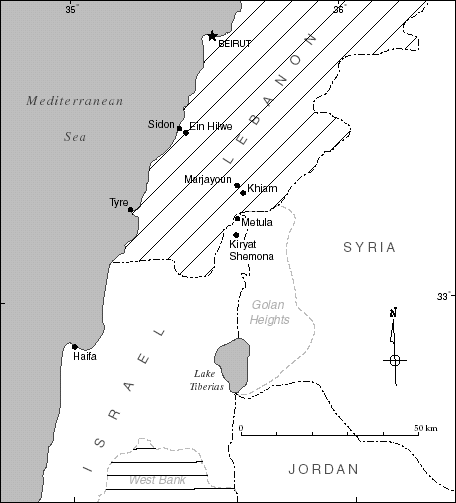The Origins of Israel's Lebanon
Counterinsurgency Frontier, 1968–78
Lebanon began serving as Israel's counterinsurgency frontier in June 1968, when Palestinian organizations launched their first guerrillas against Israel from Lebanese territory, and Israel responded with a ground attack on a small Fatah base.[33] In 1969, Palestinian guerrillas and the Lebanese government signed an agreement permitting Palestinian fighters to attack Israel from a limited area of south Lebanon.[34] The Lebanese government had originally opposed Palestinian actions from its territory, but later bowed to local and pan-Arab sentiment. After Jordan's crackdown on Palestinians in 1970–71, the guerrillas made Lebanon their new center, carving out state-like structures in Beirut-area refugee camps.[35] The PLO's administrative headquarters were in Beirut, but it deployed hundreds of fighters to the south, where they enjoyed some support from local Palestinian refugees as well as pro-Palestinian Lebanese factions.[36]
Southern Lebanese were soon trapped between PLO guerrillas on the one hand and Israeli counterinsurgency forces on the other.[37] British journalist Robert Fisk writes that Israel's attitude was straightforward: "If the Lebanese villagers allowed armed Palestinians to take shelter among their homes, then they would be made to pay for it in blood. The only way to avoid Israeli attack was to eject the Palestinians from their villages," something some Lebanese were either unwilling or unable to do, although by the late 1970s, Lebanese Shi'ite militias fought pitched battles with Palestinian factions.[38] In the early 1970s, Israeli forces regularly shelled the south and launched frequent search-and-destroy patrols by ground forces; these actions, Fisk writes, were "usually against civilian targets and always with results quite out of proportion to the original Palestinian attack," initiating a "pattern that would be expanded, developed and perfected with ferocity over the coming fifteen years."[39] Villages that did not expel Palestinians experienced particularly intense bombardment. Lebanese officials reported an average of 1.4 daily Israeli attacks in 1968–74, and an average of seven daily raids in 1975.[40] Israel's warplanes were particularly deadly, especially when attacking refugee camps. One June 1974 camp attack, for example, killed 27 and wounded 105, while a May 1975 raid killed 60 and wounded 140.[41] Israeli shelling drove many southern Lebanese northward, with one source estimating "tens of thousands" of displaced persons in the early 1970s and another speaking of 30,000 displaced households, or 150,000–300,000 persons.[42]

Map 4. Israel and South Lebanon
Israeli officials said the raids were retaliations for PLO violence, but in keeping with Israel's deterrence doctrine, its blows were more painful than those of the guerrillas. PLO forces killed 282 Israeli civilians and 250 soldiers from 1967 to July 1982, while Israel slew 3,500–5,000 civilians from 1973 to July 1982 alone. Israeli forces killed an additional 12,000–15,000 during its summer 1982 invasion, losing only 360 soldiers in return.[43] When Lebanese Shi'ites launched their own guerrilla war against Israel in the mid-1980s, Israeli leaders were surprised at the depth of popular southern Lebanese resentment against them.[44] At the same time, some southern Lebanese came to bitterly resent the Palestinian guerrillas, many of whom behaved arrogantly and attracted deadly Israeli reprisals.[45]
Lebanon collapsed into civil war in 1975, following rising tensions between Muslims, Palestinians, Druze, and Christians.[46] The Israeli-Palestinian fighting and PLO involvement in local Lebanese conflicts played a powerfully destabilizing role. Lebanese Christian factions were furious with PLO mobilization, which threatened to upset the country's confessional balance, undermine Christian power, and trigger Israeli reprisals.[47] In particular, the Christian militias were concerned because Palestinians had joined forces with leftist Muslim militias of the Lebanese National Movement. (Later on, the PLO's alliance with its Lebanese allies was disrupted, fueling the civil war even further.)[48] The civil war destroyed the Lebanese state, divided the country into warring fiefdoms, and caused tens of thousands of deaths.